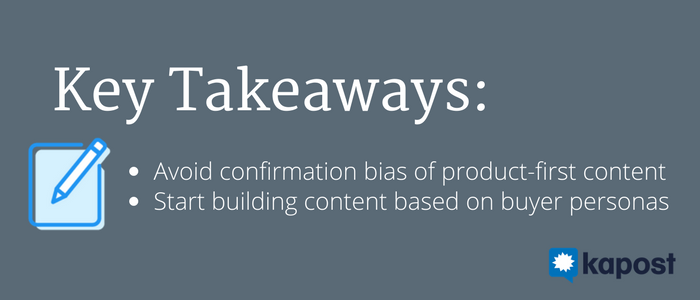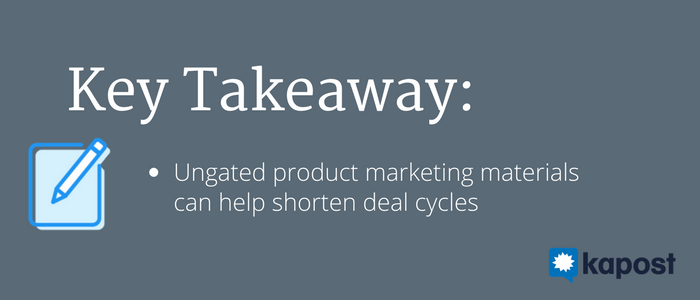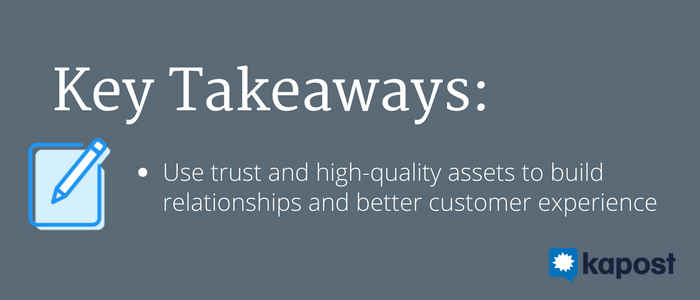In today’s buyer-controlled marketplace, creating winning B2B content is difficult. Marketers are constantly attempting to strike a balance between engaging, funnel-driving content at the top of the funnel with educational, solutions-oriented content at the bottom.
Too often, content marketers create siloed “thought leadership” content via blogs and eBooks that draw in prospects but leave them clueless to the actual solution or service the company provides. Conversely, product marketers create product-centric content that doesn’t align with the thought leadership. The result is the product gets interjected haphazardly in the marketing process, encouraging product-centric content that often doesn’t touch on customer needs or concerns.
So, how do you create both product-centric and customer-centric content?
Enter the role of the product marketer. This may sound strange as, traditionally, the role of a product marketer seems very middle- to bottom-of-the-funnel. However, this failure to connect product content across the buyer’s journey is where we run into issues (re: above). Even if you functionally create different journey-based content, a great product marketer knows how to create a seamless transition between the first touch and closed won opportunity.
This is the foundation of a well-crafted customer journey. And when customers are 5.2X more likely to purchase from companies with a great customer experience, a seamless transition from eBook download to demo to implementation is integral to not only a squishy customer experience “metric” but also revenue.

(Sorry. I couldn’t help myself.)
Keys to Successfully Developing Content with Your Buyer and Product in Mind
1. Work Backward
Ever read an exciting press release? Yeah, didn’t think so. Product launches shouldn’t just announce new features and functionality. That’s called a press release—and, like I said, they’re kinda boring.
Marketing teams need to collaborate. Product marketing launches should connect to an eBook launch from the content team. To make this a reality, work backward from your desired solution to better frame the problem, and then create content that tackles those topics and moves the buyer toward your solution. This means two things:
- Do your research about the customer—not industry, product, or solution. If you start with a solid basis of knowledge about your customer, you’ll be more prepared to address the latter three areas.
- Work together to build an integrated marketing campaign. Aligning your efforts will create a seamless buyers journey that allows your leads to gather the information they need to become a customer.
Always begin with your customer. And the best way to understand your customers are buyer personas. If you and your team have developed, researched buyer personas, you’ve done half the work already. If you don’t, I recommend you begin building personas and revisiting them on a yearly basis. You’ll see better focus and intentionality in your strategy immediately.
Product marketing can often turn into a self-fulfilling prophecy. The product marketing team knows the solution, so they build messaging around their idea. Then this messaging is sort of cross-referenced with a persona. You may get lucky, but more often than not, you’re creating an inherent bias within your product messaging because the persona is secondary to your messaging. This leaves you vulnerable to the problem of product-oriented content. When you begin with your customer and their pain points, you can build a supportive hypothesis for messaging.
Additionally, starting with your customer supports consistency in your message—and in your customer experience. This approach encourages both content and product marketing to use like-minded language throughout the content journey and avoids product-related jargon from creeping into TOFU (top-of-funnel) content.
 Takeaway
Takeaway
Avoid the common confirmation bias of product-first content, and start building content based on buyer personas.
2. Articulate Your Product Value
The role of a product marketer is to articulate the value of your product or service to your customer. Duh. Moving on…
But wait! We make value-props sound so straightforward, and yet when was the last time you stumbled on a website or downloaded an eBook and had no idea what the company actually does? Or how about when you go to a trade show, walk up to a booth, and walk away with a fidget spinner along with a lot more questions about the jargon just fed to you.
For example, for a while, the Kapost marketing team was obsessed with the idea of calling ourselves a “Marketing Operating System.” And while I stand by that messaging, we failed to support it with substantiated product messaging. There was confusion about what Kapost was and what solutions we actually provide. To solve the problem, we added additional messaging about how our software supports a powerful, content-driven marketing strategy.
In order to increase accurate product awareness, we had to articulate that the goal of Kapost is to deliver the right content to the right customer at the right time via an integrated, robust marketing platform and all-star consulting services. If we were simply to say something like, “create world-class B2B marketing with the Marketing Operating System,” people would still be scratching their heads.
It bears mentioning that access to this messaging should be easy, which means it should be ungated and be accessible without a 30-minute sales demo.
Product marketing has a massive opportunity to create clarity and differentiation in a confusing, crowded digital marketplace. Where content marketing offers valuable, “I-would-be-willing-to-pay-for-this” content, product marketing should provide straight-forward market differentiation. Only 29% of people want to talk to a salesperson to learn more about a product, while 62% will consult a search engine (HubSpot, 2016).
 Takeaway
Takeaway
Clarity of product-market fit and overall product/service value props via ungated product marketing can help shorten deal cycles, providing quality, educated buyers for sales.
3. Enable Your Internal Stakeholders
Product marketing is often described as “the glue” among sales, product, marketing, and customer success. For this reason, it makes sense that people skills are essential to the success of product marketer. Why? Because none of those internal teams really have to listen to you—at least, not without buy-in from somewhere in the organization, marketing notwithstanding.
By listening to the concerns of cross-functional teams, incorporating that feedback, and then creating high-value assets, you will, over time, earn their trust. Request to attend meetings to better understand the team dynamics and primary concerns. (Lord have mercy if you just show up. No one, literally no one, wants you creeping their calendar.) Additionally, following the two steps above ensures you have built a cohesive customer journey and set sales up for success.
When sales trusts you, they don’t cherry pick leads or have to send mountains of cold emails. Instead, prospects are primed with a cohesive story that doesn’t change when they jump into a demo. When your product team trusts you, they don’t build features without consulting your expertise. You should be a subject-matter expert for your persona internally, and then prove your worth by creating high-value assets, winning cross-functional trust and support.
Your internal stakeholders are often the gatekeepers to the bottom-funnel interactions that will make or break revenue. From sales closing deals to product building new features or launching new services, support from these stakeholders is essential. You want them to use your content and consult your expertise because it puts product marketing at the center of the customer experience. And when 85% of B2B marketers agree that consistency across content, teams, and channels is the backbone of an effective customer experience, ensuring product marketing monitors the customer experience is a very good thing.
 Takeaway
Takeaway
Use trust and high-quality assets to build impactful relationships across your organization and to create a consistent, effective customer experience.

